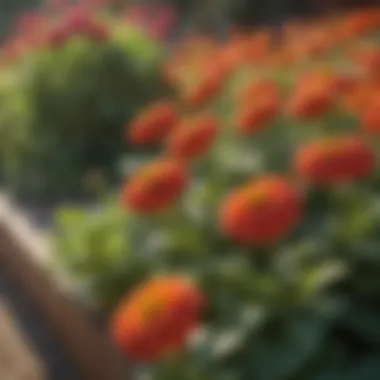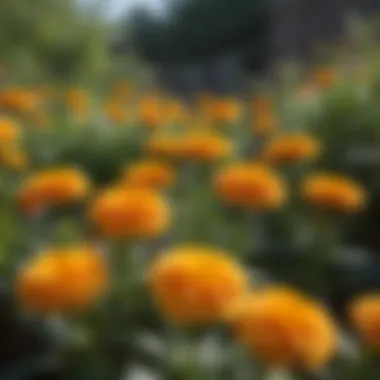Choosing the Best Flowers for Full Sun Exposure


Intro
In this article, we will dissect the characteristics of several sun-loving flowers, encompassing both annual and perennial varieties. We will also examine their unique care requirements and aesthetic potential. As gardens become havens of beauty, selecting the right blooms becomes paramount in ensuring that these spaces flourish under the sun's embrace.
Through this exploration, readers will obtain practical advice and insightful information that can considerably enhance their gardening endeavors.
Fascinating Facts About Flowers
Unique Characteristics
Flowers that thrive in full sun conditions come with distinctive traits. Many are native to regions that experience high temperatures and prolonged sunlight. These plants often have deep root systems that allow them to extract moisture from the soil more efficiently. Their leaves can be waxy or hairy, which minimizes water loss and protects them from excessive sun exposure.
Extraordinary Abilities
These flowers are specially adapted to withstand extreme climates. For instance, echinacea and lavender are not only drought-resistant but can also attract pollinators like bees and butterflies. The vibrant hues of sunflowers, zinnias, and marigolds make them excellent choices for adding brightness and attracting wildlife to any garden.
Growth Requirements
Selecting the right flowers necessitates an understanding of their specific growth needs. Most sun-loving flowers prefer well-drained soil and benefit from regular watering, especially during dry spells. It is also vital to consider the local climate when choosing specific varieties.
Annual vs.
Perennial
Annual flowers, such as petunias, provide a burst of color for a single growing season. They need to be replanted each year but often produce an impressive display. Conversely, perennials like black-eyed Susans return year after year, providing consistent beauty with less effort in the long run. Both types have their place in a sun-filled garden.
Care Tips
Caring for sun-loving flowers requires attention to several elements.
- Watering: Ensure they receive sufficient water until established. After that, many will thrive with minimal intervention, depending on the species.
- Fertilization: Regularly fertilizing during the growing season can promote vibrant blooms and robust plant health.
- Pruning: Deadheading spent flowers can encourage new blooms and prevent the plant from going to seed too early.
By gaining insights into these factors, gardeners can create a thriving environment for their chosen flowers, enhancing not only their immediate surroundings but also fostering biodiversity.
Finale
Preface to Full Sun Gardening
Gardening in full sun conditions presents unique challenges and opportunities. Understanding how to select flowers that thrive in such environments not only beautifies outdoor spaces but also contributes to the overall health and enjoyment of a garden. This section aims to highlight key elements associated with full sun gardening, including plant choices, growth considerations, and the benefits flowers can offer in sunny areas.
Defining Full Sun
When we talk about full sun, it refers to areas that receive six or more hours of direct sunlight daily. This definition is crucial for selecting appropriate flowers. Many plants, particularly those that flourish in full sun, have adapted to withstand intense heat and prolonged exposure. Understanding this definition helps gardeners make informed decisions about where to plant and which species will endure these conditions best.
In full sun areas, one should pay attention to their climate. Different regions may experience varying degrees of sunlight intensity and heat. It is essential to evaluate the microenvironment of your garden, considering factors such as airflow, soil quality, and moisture levels.
Benefits of Full Sunflowers
Choosing flowers for full sun conditions can enhance a garden's aesthetics and biodiversity. Sun-loving flowers tend to be vibrant and more resilient against disease and pests compared to those which thrive in shade. They often attract beneficial insects like bees and butterflies, contributing to a healthier ecosystem.
Here are a few notable benefits:


- Vibrant Colors: Flowers like Marigolds and Zinnias display rich, vibrant colors when provided with adequate sunlight. This lively appearance enhances visual appeal in any garden.
- Resilience: Plants that flourish in full sun often exhibit greater durability and adaptability. They typically tolerate drought better than shade-loving varieties.
- Extended Blooming Periods: Many sun-loving flowers have longer blooming periods, providing consistent color and beauty throughout the growing season.
Textural and visual contrasts achieved by mixing different flowering species can create a dynamic environment that captivates both the observer's eye and encourages nature’s vital pollinators.
By recognizing the significance of full sun in gardening, one can optimize flower selection and embrace the benefits that come from cultivating robust, sun-loving blooms.
Characteristics of Sun-Loving Flowers
Understanding the characteristics of sun-loving flowers is crucial when selecting the right blooms for a garden that experiences full sun. These flowers display unique features that make them ideal for warm and sunny environments. Not only do they add visual interest to a landscape, but they also contribute to the overall health of the ecosystem by attracting pollinators and supporting local wildlife.
Adapting to Heat
Sun-loving flowers have evolved to thrive under intense sunlight and high temperatures. They possess various adaptations that help them cope with these conditions. For instance, many of these flowers have deep root systems that allow them to access moisture from deeper soil layers, making them more drought-resistant.
Some common adaptations include:
- Thick leaves: Many sun-loving plants develop thicker leaves, which minimizes water loss through transpiration.
- Reflective surfaces: Some flowers have shiny or hairy surfaces that reflect sunlight, reducing the risk of overheating.
- Seasonal growth: Many of these plants have adapted their growth cycles to bloom during the hottest months, ensuring their life cycles align with optimal conditions.
By understanding these heat adaptations, gardeners can better appreciate the resilience of sun-loving plants and choose varieties that can withstand harsh conditions.
Water Requirements
The water needs of sun-loving flowers are essential for their growth and longevity. Despite their ability to endure heat, these flowers still require adequate hydration to thrive. Different species have varying tolerances to drought and moisture, highlighting the importance of selecting flowers that align with specific water availability in the garden.
General water requirements include:
- Regular irrigation: Many sun-loving plants benefit from weekly watering, especially during dry spells. Ensuring soil remains consistently moist helps with nutrient absorption.
- Drought-tolerant options: Some varieties, like succulents or certain native plants, are incredibly resilient and can survive with minimal watering once established.
- Soil drainage: Good drainage is essential. Heavy soils can retain water and lead to root rot, so selecting flowers adapted to specific soil conditions can enhance growth.
Ultimately, understanding how different sun-loving flowers interact with water will allow gardeners to cultivate a thriving garden that meets both aesthetic and environmental needs.
Top Annual Flowers for Full Sun
Choosing the right flowers for areas that receive full sun is essential for creating a bold and vibrant garden. Annual flowers are particularly advantageous in these settings, as they often bloom profusely and provide a wide array of colors and forms throughout their growing season. They allow gardeners the chance to switch out varieties from year to year, which can lead to both aesthetic changes and improved pollinator support over time.
When selecting annual flowers for full sun, it is crucial to consider their heat tolerance and water needs. Flowers that thrive in bright light conditions not only tolerate heat but often produce more blooms when exposed to longer sun hours. Additionally, full sun annuals can serve as a foundation for your garden, offering structure and form while other perennials take time to establish.
Top Perennial Flowers for Full Sun
Choosing the right perennial flowers for full sun conditions is essential for creating a vibrant and sustainable garden. Perennial flowers offer various benefits. They return year after year, providing consistent beauty and less maintenance compared to annuals. Additionally, selecting the right species can improve garden resilience, attract pollinators, and contribute to soil health. Understanding which perennials thrive in full sun can expand your planting options and enhance the visual appeal of your outdoor space.
Daylilies
Daylilies, known scientifically as Hemerocallis, are a standout option for full sun gardens. They are resilient and adaptable, thriving in various soil conditions. Their blooms come in numerous colors ranging from yellows to deep purples. Daylilies typically bloom for only one day; however, many varieties produce multiple flower stalks, extending the bloom period throughout the season. They are also drought-tolerant once established, which makes them an excellent choice for homeowners seeking low-maintenance options.
Additionally, daylilies attract beneficial insects, aiding in pollination and biodiversity. Their foliage adds a lush green element even when not in bloom. It's worth noting that these plants can spread quickly, so consider providing adequate space when planting.
Black-eyed Susans
Black-eyed Susans, or Rudbeckia hirta, are a popular choice for full sun gardens. These flowers are recognized for their striking golden yellow petals and dark centers. They can create a cheerful atmosphere in any garden. Black-eyed Susans are also hardy and adaptable, thriving in poor to average soils, making them an ideal choice for less fertile areas.
Their long blooming period from summer to fall provides continuing color in the garden. This flower attracts various pollinators, enhancing garden biodiversity. While they are generally resistant to pests, providing adequate spacing can further inhibit the spread of any potential diseases.
Coneflowers


Coneflowers, specifically Echinacea, are highly valued for their resilience to full sun conditions. These perennials come in several varieties, commonly displaying pink, purple, or white blooms. Coneflowers are noted for their medicinal properties, often used in herbal remedies. They also attract a range of pollinators including bees and butterflies, contributing to a lively garden ecosystem.
Coneflowers prefer well-drained soils and can tolerate dry conditions once established. This feature makes them suitable for gardeners looking for drought-resistant options. Like many perennials, they can spread over time, making them a good choice for filling garden spaces. Their seed heads also provide winter interest and food to birds.
In summary, when selecting perennial flowers for full sun, consider the specific characteristics of daylilies, black-eyed Susans, and coneflowers. Each offers unique benefits and can contribute to a sustainable and beautiful garden.
Unique Flower Varieties for Marginal Spaces
In the quest for vibrant blooms in full sun conditions, one must consider unique flower varieties that thrive even in marginal spaces. Such areas may include rocky terrains, narrow borders, or spots with poor soil quality. Recognizing these adaptable plants is vital for gardeners aiming to maximize every corner of their outdoor space. These flowers not only provide aesthetic value but also serve ecological purposes, attracting pollinators and enhancing biodiversity.
Succulents
Succulents are remarkable for their ability to withstand drought, making them ideal for full sun areas with limited water availability. These plants store moisture in their leaves, stems, or roots. They are particularly well-suited for rock gardens and containers, offering a unique texture and variety.
- Popular succulents include:
- Echeveria
- Sedum
- Agave
When planting succulents, ensure they have well-draining soil to prevent root rot. Their low maintenance nature makes them perfect for busy gardeners. Some succulents produce adorable flowers, like the Echeveria, which can further enhance the appeal of your sun-drenched space.
Lavender
Lavender is not just a fragrant herb but also a stunning ornamental flower. It thrives in sunny locations, needing well-drained soil and minimal watering once established. Lavender’s resilience to heat makes it a prime candidate for full sun gardens.
- Benefits of lavender include:
- Attracting pollinators like bees and butterflies.
- Serving as a natural pest repellent.
- Providing a calming scent that can enhance outdoor relaxation spaces.
This plant can also be harvested for culinary use or for creating homemade potpourri. Placement in mass plantings can create a visually striking display while drawing in beneficial insects.
Sedums
Sedums, also known as stonecrops, are hardy, succulent plants that excel in full sun conditions. They come in various species and offer unique forms and textures. Sedums are particularly adaptable to poor soils, thriving where other plants may struggle.
- Some common sedum types are:
- Sedum spectabile
- Sedum acre
- Sedum album
They require minimal upkeep and are drought-resistant, making them an excellent choice for gardeners focusing on low-maintenance gardens. Sedums bloom from summer into fall, providing crucial forage for pollinators during these seasons.
Care Tips for Sun-Loving Flowers
Caring for sun-loving flowers requires attention to several key factors. These flowers, while robust and adaptive, have specific requirements to truly flourish in full sun conditions. Understanding these elements can lead to healthier plants and a more vibrant garden. The right strategies can ensure your blooms not only survive but also thrive in sunlight, ultimately enhancing the beauty of your outdoor spaces.
Watering Strategies
Watering is essential for the health of any flower, especially those in full sun. Flowers exposed to direct sunlight may lose moisture faster than those in partial shade. It's important to establish a routine that meets the needs of the particular flowers you grow.
- Frequency: Aim to water early in the morning or late in the afternoon to reduce evaporation. During peak heat, you may find that daily watering is necessary.
- Techniques: Drip irrigation or soaker hoses can provide consistent moisture at the plant's roots without wetting the foliage. This reduces the risk of fungal diseases.
- Signs of Underwatering: Look for wilting leaves or dry soil. If the leaves are browning at the edges, it may indicate stress from lack of water.
By adapting your watering strategy to the flowes' needs, you can promote healthy growth and blooming.
Soil Conditions


Soil quality is another critical component in fostering healthy flowers in full sun. Plants need well-draining soil to prevent root rot and other moisture-related issues. Here are some considerations:
- pH Levels: Conduct a soil test to determine the pH level. Most flowers prefer a slightly acidic to neutral pH (around 6.0 to 7.0).
- Organic Matter: Incorporating compost can improve soil structure, enhance nutrient content, and improve drainage. It also helps retain moisture, which is beneficial in hot conditions.
- Drainage: Ensure your planting area has adequate drainage. If the soil retains too much water, consider raised beds or adding sand to increase drainage.
Maintaining optimal soil conditions will support healthy root systems and robust growth.
Fertilization Needs
Proper fertilization is crucial for flowers to reach their full potential. In full sun, flowers can quickly deplete the soil of nutrients. Thus, a thoughtful fertilization strategy is advisable:
- Type of Fertilizer: Choose a balanced fertilizer, providing equal parts nitrogen, phosphorus, and potassium. This can help promote healthy foliage as well as flowering.
- Application Timing: Start fertilizing in early spring when growth begins, and follow up every few weeks during the growing season. Be careful not to over-fertilize, as this can lead to excessive leaf growth at the expense of blooms.
- Slow-Release Options: Consider using slow-release fertilizers. They provide consistent nutrient availability, reducing the need for frequent applications.
By addressing fertilization needs, you can nurture your flowers, leading to vibrant and long-lasting blooms.
Proper care of sun-loving flowers can transform your garden into a stunning spectacle, showcasing the beauty of nature.
In summary, paying close attention to watering strategies, soil conditions, and fertilization needs sets the foundation for a thriving garden of sun-loving flowers.
Common Challenges in Growing Flowers in Full Sun
Growing flowers in full sun conditions presents several challenges. Understanding these issues is essential for anyone looking to create a vibrant garden. Flowers in full sun face unique stressors, and awareness of these factors can significantly improve success rates.
Pest Management
Pests are often drawn to the vibrant colors and fragrances of flowers. Common pests include aphids, spider mites, and whiteflies. Each pest presents its own set of challenges. Proper management begins with identifying the pest accurately. For effective intervention, gardeners should consider natural remedies like neem oil or insecticidal soap. Additionally, introducing beneficial insects such as ladybugs can help maintain balance in the ecosystem.
Some strategies for pest management include:
- Regular Inspection: Frequent checks on plants can identify problems early.
- Cultural Practices: Adjusting watering and feeding schedules can reduce pest attraction.
- Diverse Planting: Mixing different flower types can deter specific pests.
It is important to remain vigilant. Left unchecked, pest infestations can diminish the health and beauty of flowers, even in ideal sun conditions.
Disease Prevention
Disease is another critical aspect of managing full sun gardens. High temperatures and direct sunlight can create an environment conducive to fungal and bacterial diseases. Common issues include powdery mildew, root rot, and leaf blight. Understanding the specific disease cycle is key to prevention.
An efficient disease prevention plan involves several aspects:
- Choosing Resistant Varieties: Some flowers are bred to resist specific diseases, which is worth considering when selecting plants.
- Proper Watering Techniques: Watering methods can affect disease spread. Drip irrigation reduces water on foliage, lowering the risk of fungal growth.
- Air Circulation: Ensuring adequate space between plants helps increase airflow, which is crucial for minimizing disease risk.
Key Insight: Dedicated care can combat both pests and diseases. By incorporating these practices, gardening enthusiasts can ensure blooming success.
Gardening in full sun settings can be rewarding. But it requires knowledge about the challenges . With the right management strategies in place, these potential issues can be effectively mitigated. This way, vibrant flowers will flourish, creating stunning outdoor spaces.
Closure: Crafting a Vibrant Flower Garden
Creating a vibrant flower garden requires thoughtful consideration of several factors. When selecting flowers for full sun conditions, understanding the specific needs and characteristics of different types is crucial. Flowers that thrive in direct sunlight not only contribute beauty but also enhance biodiversity in your outdoor spaces. This can have a positive impact on local wildlife, encouraging pollinators such as bees and butterflies to visit.
Choosing the right flowers involves evaluating which varieties complement each other in terms of colors and bloom times. Combining species such as marigolds, coneflowers, and zinnias can result in an eye-catching display that changes with the seasons. The layout of your garden is also significant. Grouping similar plants together can improve their growth conditions and create a harmonious look.
Additionally, understanding the care requirements of these sun-loving plants will lead to more successful gardening experiences. Proper watering, soil conditions, and fertilization techniques need to be implemented to sustain the health and vibrancy of your flowers. This will ultimately affect the longevity of blooms and overall aesthetic appeal.
Crafting a vibrant flower garden, particularly in full sun environments, is about more than just aesthetics; it also fosters ecological health in your area.
Final Thoughts on Flower Selection
It is advisable to research specific varieties that excel in your region. For instance, black-eyed Susans and daylilies are beloved for their resilience and beauty. Remember that the balance of diversity in plant selection can also mitigate potential pest issues and promote a more robust ecosystem.
Overall, the journey of crafting a flower garden in full sun is rewarding. The process itself teaches valuable lessons about nature's intricacies, ultimately leading to a vibrant and flourishing outdoor space.







